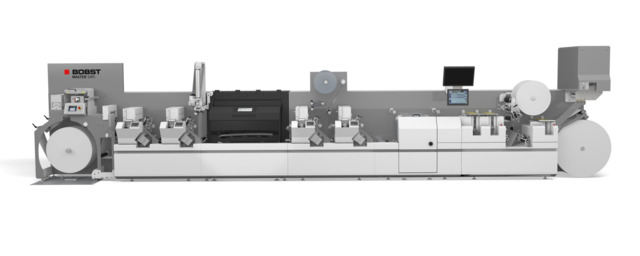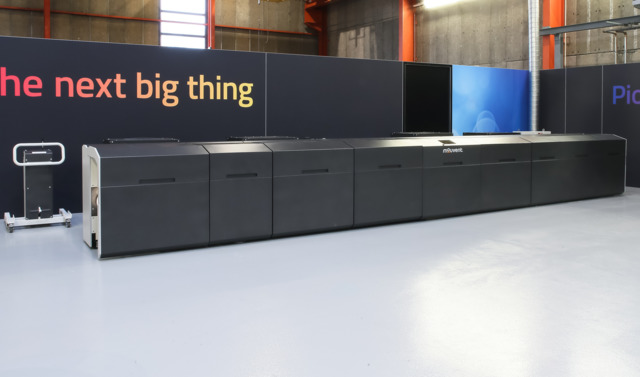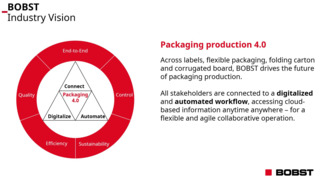BOBST Ups the Stakes with Next-Generation Hybrid Press and More
BOBST has been providing solutions to the printing and packaging industries for four generations, and more recently has added digital textile printing to the mix.

 BOBST MASTER DM5 Hybrid Label PressBOBST has been providing solutions to the printing and packaging industries for four generations, and more recently has added digital textile printing to the mix. Perhaps when you think of BOBST, you think die-cutting, folder gluer, flexo; but these days, the company is so much more. We checked in with CEO Jean-Pascal Bobst to get the latest news and his views about the industry.
BOBST MASTER DM5 Hybrid Label PressBOBST has been providing solutions to the printing and packaging industries for four generations, and more recently has added digital textile printing to the mix. Perhaps when you think of BOBST, you think die-cutting, folder gluer, flexo; but these days, the company is so much more. We checked in with CEO Jean-Pascal Bobst to get the latest news and his views about the industry.
PN: You had a pretty significant presence at Labelexpo Europe and made some exciting announcements. Can you share the highlights with our readers?
JPB: What we showed at Labelexpo Europe demonstrates our vision of the future of the industry – more digitization, more connectivity and the ability to supply most, if not all, required solutions for flexo and digital. We see growing demand for labels, packages and packaging machinery, and this has driven growth for us in the last few years. Along with that, we have made significant digital investments, including in our Mouvent technology, which supports digital printing in five industries, and into Industry 4.0 solutions that we believe will shape the future of packaging production across labels, flexible packaging, folding carton and corrugated board. The goal is to move from a PDF file to an end product with as little human intervention as possible. It’s all about the ability for stakeholders to be connected to a digital and automated workflow, accessing cloud-based information anytime, anywhere, for a flexible and agile collaborative operation. BOBST can provide software, ink, machines and strong relationships that help customers make the necessary transformations in their businesses.
PN: You talk about REVO as an important part of this go-forward strategy. Can you explain what that is?
JPB: REVO, which was started in 2013, is a group of leading companies in labels and packaging. REVO stands for Digital Flexo REVOlution and aims to establish a new standard for labels and packaging production. To date, nine other companies have joined us in this effort.
PN: The MASTER DM5 digital label press you announced at Labelexpo is an example of this strategy in action. I see that it also incorporates the Mouvent Cluster technology for delivery of digital UV inkjet.
JPB: Yes, it is a multi-process printing and converting system that can print at up to 100 meters per minute and has on-the-fly, non-stop job changeover. It’s a hybrid analog/digital solution that demonstrates the ability to go from PDF to final product, all in-line and with proper quality control systems in each stage of the process. In addition to in-line flexo and digital printing, it also offers high-speed semi-rotary die cutting, as well as on-the-fly die-cutting unit changes, non-stop waste stripping path change for maximum uptime, and a variety of foil stamping options. With the inkjet component, of course, packages can be personalized, versioned, serialized or customized right in line. We believe this hybrid approach to packaging manufacturing is the future of the industry.
PN: But you do offer some all-digital solutions as well?
JPB: Yes. At Labelexpo, we showed the Mouvent LB702-WB six-color label printer with sustainable water-based inks as well as the Mouvent LB701-UV with six colors plus white with a robust UV ink set. Those printers run at 100 and 70 meters per minute, respectively, with 1200 dpi resolution.
 Mouvent LB702-WB Water-Based Digital Label Press
Mouvent LB702-WB Water-Based Digital Label Press
PN: At ITMA, we saw the new digital textile printer Mouvent launched.
JPB: The Mouvent TX802 multipass digital textile printer runs at 400 square meters per hour at a print resolution of 200 dpi with a choice of reactive, acid, disperse or pigment inks, so we can address any fabric type.
PN: What are you seeing in terms of installations in textiles?
JPB: We have 15 units installed, with two in China. Right now, about two-thirds are TX801, the 200-square-meters-per-hour version, but we expect to see that flip to two-thirds TX802 because you can double the output within about the same footprint. We are putting efforts into reducing ink waste and therefore water pollution. If you look at total cost of ownership numbers, our printers cost about 20% less than others in the market per linear meter.
PN: Both label and textiles are in the midst of an analog-to-digital transformation. How do you see that progressing?
JPB: In labels and packaging, as soon as you have Industry 4.0 solutions with the right print quality and total cost of ownership, digital printing will take a large share of packaging printing on many different substrates. Our Mouvent water-based inks are 100% food safe compliant and more cost-effective that UV. We believe we have the solutions for what the industry will need tomorrow. The transformation is not as far along in textiles, but the same conditions apply.
PN: Drupa will be here before we know it. You launched a lot of new products at Labelexpo. Will we see more new products from you at drupa 2020? And what do you think the focus of drupa 2020 in general will be?
JPB: With Industry 4.0, most of the players will be coming to drupa with connected solutions. We will show how you can offer full connectivity within a production plant as well as better serve customers from a software and application standpoint. For BOBST, this is a big evolution, but it is necessary to become a one-stop shop from software to applications, to applications and ink chemistry, to print and finishing. We are now well down that path. We will continue to focus on the delivery of products along this strategy year after year.
PN: What advice do you have to printers/converters about how to expand their business offerings? What are the hot applications they can explore, and how do they research those options?
JPB: Connectivity and automation are important. We delivered some of this at Labelexpo and there will be more to come at drupa. We also think people should be looking at opportunities around sustainability for all substrates. Plastic bans, concerns about recyclability, and UV migration should be a major concern for everyone and should be taken seriously. That is not a joke or a political message. It’s a reality, and we think we can demonstrate ways for people to be more sustainable, in both packaging and textiles. We have to come to market with solutions which fit our customers’ and brand owners’ expectations on print quality, sustainability and TCO.



